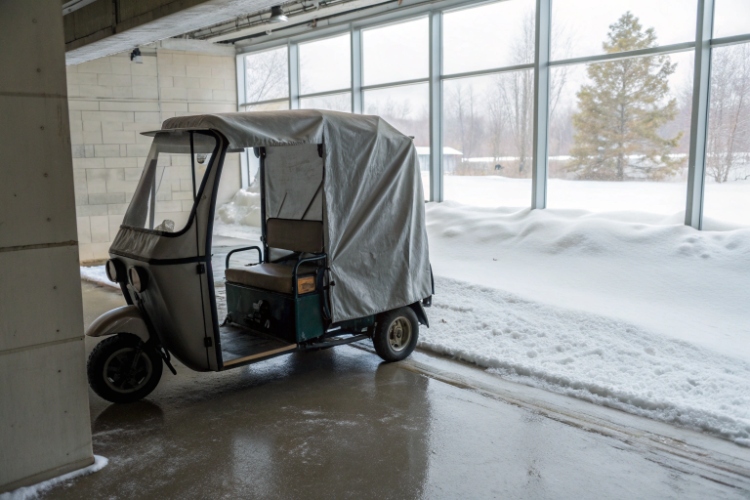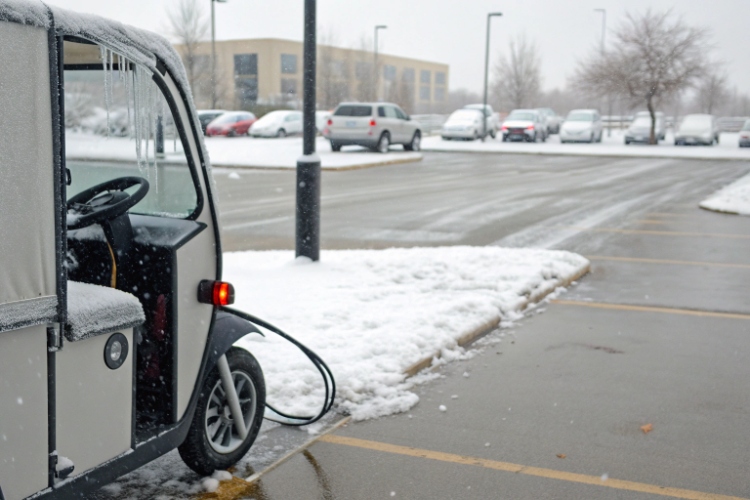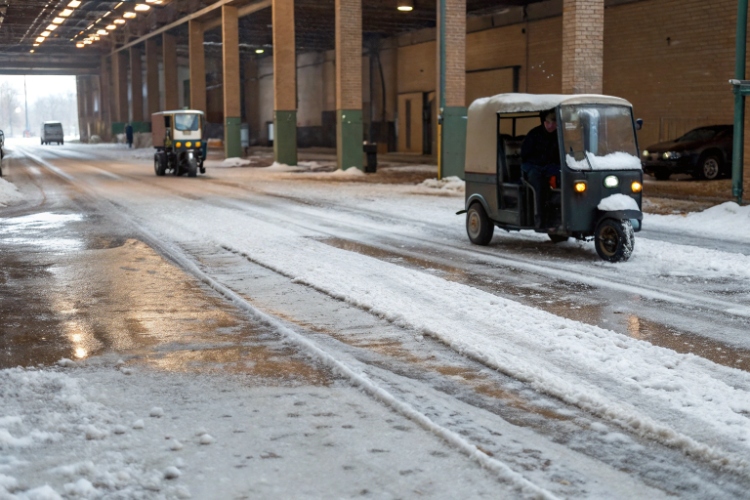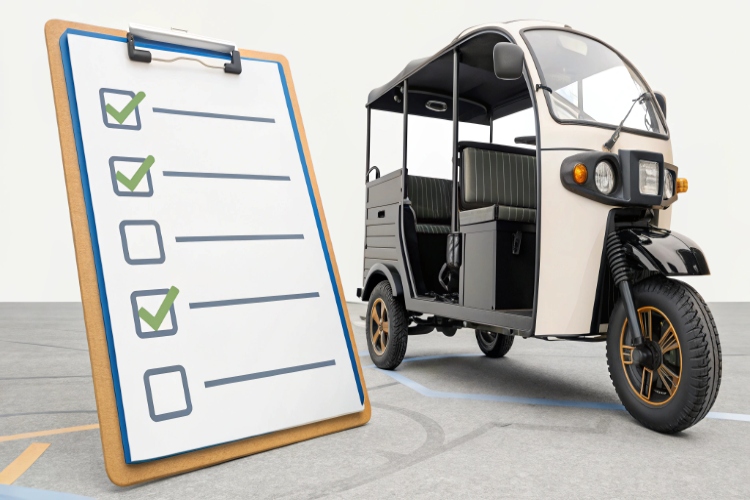Winter is coming, and your electric rickshaw fleet is slowing down. This lost range costs you money and leads to service disruptions. Protect your fleet and profits with these essential winter maintenance tips.
Winter maintenance for an electric rickshaw focuses on protecting the battery from the cold, preventing rust and moisture damage, and ensuring mechanical parts like brakes and tires are adjusted for safe operation on slippery roads. Parking indoors and charging after use are crucial habits.

Every year, as the temperature drops, I get calls from my distributors in colder regions. Their main complaint? Their electric tuk-tuks, which ran perfectly in the summer, are suddenly struggling. The driving range is shorter, and the power feels sluggish. This isn't a defect; it's the reality of how batteries and vehicles behave in the cold. The good news is that with a little bit of preparation and some simple daily habits, you can minimize these effects and keep your fleet operating reliably and profitably, even on the coldest days. Let's go over the key areas we advise our partners to focus on.
How does cold weather affect battery performance and driving range for electric tricycles?
Your driver starts the day with a full charge, but the battery dies much faster than expected. This means fewer trips, lower revenue, and the risk of being stranded far from a charger.
Cold weather dramatically reduces battery range because it slows down the internal chemical reactions that produce electricity. A battery that provides a full range in warm weather might lose 30% to 50% of its capacity in freezing temperatures.

This is the number one issue for any electric vehicle in the winter. The battery is like a chemical engine, and cold slows those chemicals down. From our testing and client feedback, the drop in performance is predictable. I always share this data with fleet managers so they can adjust their daily route planning.
| Outside Temperature | Approximate Reduction in Driving Range |
|---|---|
| 10°C (50°F) | ~15% Reduction |
| 0°C (32°F) | ~30% Reduction |
| -10°C (14°F) | ~45% Reduction |
Beyond just a shorter range, cold weather also increases the battery's self-discharge rate when idle. A rickshaw left sitting in the cold for 3-4 days can lose a significant amount of charge, and if left for a week, it could be completely empty. This deep discharge is very damaging to lead-acid batteries. To combat this, we advise clients in very cold regions to specify low-temperature resistant batteries and ensure all wiring has cold-resistant insulation to prevent it from becoming brittle and cracking.
What daily charging and parking habits help protect the battery in low temperatures?
You know the cold is bad for batteries, but you're not sure what practical steps to take. You need simple, effective habits to protect your expensive battery packs from premature failure.
The two most important habits are to park the vehicle indoors and to charge it immediately after the day's work is done. A warmer battery is a healthier battery, and it charges much more efficiently than a stone-cold one.

Think of it this way: you're protecting the heart of your vehicle. Parking indoors, even in an unheated garage or warehouse, keeps the battery several degrees warmer than leaving it outside in the freezing wind and snow. This makes a huge difference.
The second habit is just as important: charge the battery right after you finish using it. The battery is still warm from operation, and a warm battery accepts a charge much more effectively. Trying to charge a frozen battery is inefficient and can even cause damage.
Driving style also becomes a critical maintenance habit in winter. Sudden, hard acceleration is the biggest power draw on a battery. In the cold, this puts extreme stress on the already struggling battery.
| Good Winter Habit | Bad Winter Habit |
|---|---|
| Park indoors or under a cover. | Park outside, exposed to snow and wind. |
| Plug in to charge immediately after use. | Wait until morning to charge the cold battery. |
| Accelerate smoothly and gradually. | Use full throttle for "jack-rabbit" starts. |
| Brake slowly and anticipate stops. | Slam on the brakes at the last second. |
By training your drivers on these simple points, you save a massive amount of energy, which directly translates to longer range and a longer lifespan for your battery packs.
How can I prevent rust, moisture damage, and brake issues during winter use?
Winter roads are covered in salty slush and moisture. You worry about your fleet's frames rusting, electrical systems shorting out, and brakes failing on slippery roads, creating a safety hazard.
Combat winter's effects by storing vehicles in a dry place, regularly checking tire pressure, and ensuring brakes are properly adjusted. Wiping down the vehicle to remove salt and slush is also crucial for preventing long-term corrosion.

Mechanical parts take a beating in the winter. Moisture is the enemy of any metal component, and the salt used to de-ice roads is extremely corrosive. The key is proactive, not reactive, maintenance.
First, Shinalar bosimi. Cold air is denser, so your tire pressure will drop in the winter. An under-inflated tire has a larger contact patch with the road, which dramatically increases rolling resistance. This forces the motor to work harder and consumes more battery power. Check the pressure weekly.
Second, Tormoz. Brake cables can accumulate moisture and rust, causing them to stick. A dragging brake is like driving with the emergency brake partially on—it kills your range and wears out parts. In freezing weather, a wet brake cable can even freeze solid. We advise drivers to test the brakes before every trip and ensure the brake levers return to their original position smoothly.
Finally, Cleaning and Storage. At the end of the day, wipe down the frame and undercarriage to remove slush and salt. This single step can add years to the life of the vehicle's frame. Storing it in a dry place, away from rain and snow, prevents moisture from seeping into electrical connectors and causing shorts.
What pre-winter inspection steps should fleet owners take to keep electric tuk-tuks running smoothly?
The first snow is forecast, and you suddenly realize your fleet isn't ready. A breakdown now could halt operations, but you don't know where to start your inspection.
A pre-winter checklist is your best tool. Before the cold sets in, inspect every vehicle's tires, brakes, battery health, and all electrical wiring. This proactive check prevents the majority of winter-related breakdowns and ensures fleet reliability.

For our fleet clients, we provide a simple pre-season checklist. Preparing your fleet before the first freeze is far cheaper than dealing with emergency repairs in the middle of a snowstorm. This is the checklist I give them:
-
Check Tires : Don't just look—use a gauge. Inflate all tires to the recommended PSI. Check the tread depth. Worn tires are extremely dangerous on wet or icy roads. Replace any that are nearing the end of their life.
-
Check Brakes : Test the brake performance. Do they stop the vehicle effectively? Check the brake cables for any signs of rust or fraying. Ensure brake levers and pedals move freely and don't stick.
-
Check Wiring: Visually inspect all exposed electrical wiring. The cold can make old insulation brittle and prone to cracking. Look for any cracks that could let moisture in. Secure any loose connectors.
-
Plan for Charging & Storage : Confirm you have a dry, sheltered space for your fleet. Ensure your charging station is protected from the elements. Remind all drivers of the "charge after use" policy.
-
Train for Winter Driving : Hold a brief safety meeting. Remind drivers to reduce speed, increase following distance, and avoid sudden acceleration or braking on potentially slippery surfaces.
This simple, one-hour inspection per vehicle can save you weeks of headaches and lost revenue.
Xulosa
Proactive winter care focusing on battery protection, moisture prevention, and mechanical checks ensures your electric rickshaw fleet remains reliable and profitable all season long.

